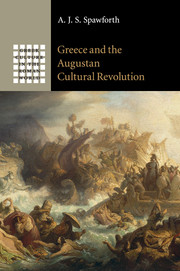Book contents
- Frontmatter
- Contents
- Illustrations
- Acknowledgments
- Chapter 1 Introduction
- Chapter 2 ‘Athenian eloquence and Spartan arms’
- Chapter 3 ‘The noblest actions of the Greeks’
- Chapter 4 ‘The gifts of the gods’
- Chapter 5 ‘Constructed beauty’
- Chapter 6 Hadrian and the legacy of Augustus
- Conclusion
- Bibliography
- Index
- References
Chapter 3 - ‘The noblest actions of the Greeks’
Published online by Cambridge University Press: 05 November 2011
- Frontmatter
- Contents
- Illustrations
- Acknowledgments
- Chapter 1 Introduction
- Chapter 2 ‘Athenian eloquence and Spartan arms’
- Chapter 3 ‘The noblest actions of the Greeks’
- Chapter 4 ‘The gifts of the gods’
- Chapter 5 ‘Constructed beauty’
- Chapter 6 Hadrian and the legacy of Augustus
- Conclusion
- Bibliography
- Index
- References
Summary
Roman views
If the Agrippeum was intended to provide a prestigious showcase for the Attic muse, including the new medium of public declamation, an art form to be applied inter alia to the celebration of old Greek victories, this purpose only makes sense in a climate of marked Roman interest in ancient Greek wars. Augustan ideology fostered just such a climate. Research over the last quarter-century has shown that Augustus and his regime were acutely aware of the historical parallelism between contemporary threats from the east and the struggle between Classical Greece and ‘barbarian’ Persia. This parallelism made available for imperial use a rich stock of prestigious images themed around the idea of the defence of (Greek) civilisation against the forces of barbarism. Roman artists first brought this imagery into play soon after Actium. Tonio Hölscher has argued that behind a scattered group of Roman reliefs are two lost prototypes – perhaps a pair – put on display in early-Augustan Rome. These referenced the Greek naval victory at Salamis in 480 bc by means of Athena and her snake, a trophy of captured arms including a pelta or half-moon shield of eastern type, a winged Victory holding the curved poop of a ship, and a warrior of Classical type, bearded and wearing a Corinthian helmet. These lost originals were clearly well known, since they inspired variant versions as far afield as Beirut – the Syrian region being home to provincial grandees closely attuned to Augustan values, as the case of C. Iulius Nicanor, of Hierapolis Bambyce, will show (below). The fame of these originals reflected the ‘high ideological significance’ of their subject matter: Salamis was a metaphor for Actium, the seminal victory on which the Augustan principate was founded and which Augustus now used to portray himself as the champion of civilisation against eastern barbarians.
The regime returned to this parallelism in 20 bc when Augustus visited the province of Syria to negotiate the return of the standards and Roman prisoners captured in the Parthian defeat of Crassus in 53 bc. As part of his propagandistic presentation of this diplomatic settlement as a victory for Roman arms, Augustus commissioned two identical monuments of an unmistakable Romanity, despite their incorporation of victory tripods in the manner of the famous thanks-offering which the Greeks dedicated at Delphi after the decisive victory at Plataea. Pausanias saw one of these monuments in the Olympieum at Athens: ‘There are some Persians in Phrygian stone holding up a tripod: the Persians and the tripod are both worth seeing.’ Rolf Schneider has identified the three supporting barbarians from the second monument in two figures now in Naples and a third in Copenhagen. Even without the outsize tripod which they originally supported, these figures have a spectacular quality achieved by their colossal size – although kneeling they are over 1.5 metres high without the tripod – and by the material, so-called ‘Phrygian marble’, a polychrome stone from Asia Minor employed by Roman sculptors to symbolise the eastern provenance of the barbarians themselves. Schneider argues that the original monument to which these scattered figures once belonged – second of the pair – was set up by Augustus in his new temple complex of Apollo on the Palatine: ‘not only a unique showcase for the political and religious self-representation of the imperial regime inaugurated with Augustus but equally also one of the most important centres of Augustan Rome’. If Schneider is right, the choice of the Olympieum in provincial Athens as a pendant for this prestigious locale in the capital underscores the importance of Athens for Augustus as the main locus, since Alexander's day, for the commemoration of the Greek struggle against eastern barbarism. As we shall see, Sparta had similar associations; so did Plataea. The difference was that, in choosing Athens, the regime exploited the traditional character of the city as a ‘beacon’ in order to beam its ideology to the broadest eastern audience.
- Type
- Chapter
- Information
- Greece and the Augustan Cultural Revolution , pp. 103 - 141Publisher: Cambridge University PressPrint publication year: 2011

